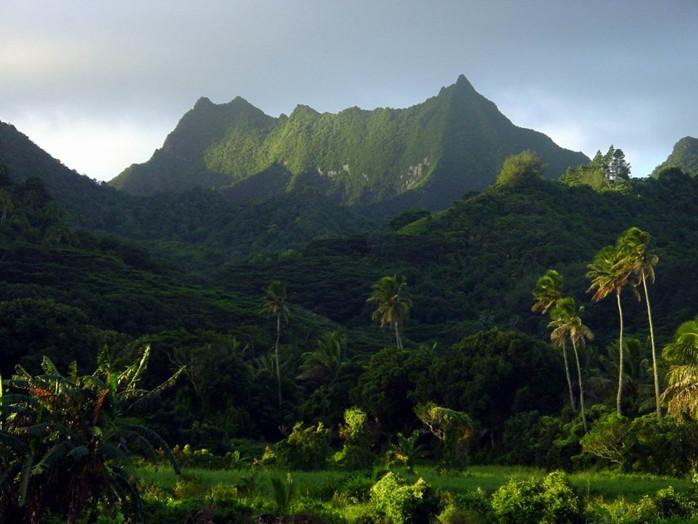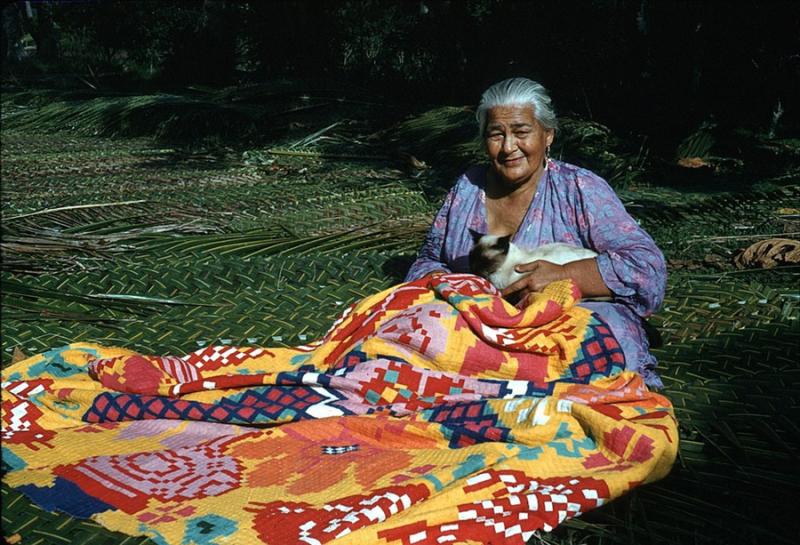Facts and figures
| Official name | Cook Islands |
| Country code | CK |
| Area | 236km2 |
| Coastline | 120km |
| Population | 18,100 |
| Capital city | Avarua |
| Timezone | UTC-10:00 |
| GDP | $USD 0.26 billions |
| Currency | CKD (Cook Islands dollar $) |
| Government type | Unitary Constitutional Monarchy |
| Notable people |
|
The ‘Know Your Region’ series is designed to support unit and individual professional military education on the Indo-Pacific region. It’s important for all serving members of our military to have a foundational knowledge of the countries and issues in the Indo-Pacific.
Cook Islands is a self-governing island state in free association with New Zealand. It is located in the South Pacific between Samoa and French Polynesia, around 3,000km north-east of New Zealand. The country is made up of 15 small islands with a total land area of 256 km2 spread out over 200,000 km2 of ocean. There are two distinct island groups – the northern group which includes six islands, and the southern group which includes nine.
The total population is approximately 14,000 (Jan 2024) with over 10,000 people living on the principal island of Rarotonga in the southern group. With a land area of only 67 km2 (11km at its widest points) it takes only 1-2 hours to cycle around the island and only 3-4 hours to walk across it. Rarotonga has the nation’s highest extinct volcano at 652 metres above sea level and is home to the only international airport. The Island's original road that runs around the outside is thought to be at least 1200 years old and is regarded as one of the best achievements of ancient Polynesian engineering.

Due to the distance between islands, there are a variety of ecosystems, including tropical rainforests and coastal mangroves on the southern islands and spectacular atolls, surrounded by saltwater lagoons and circular coral reefs in the north. The islands are home to unique flora and fauna, including endemic bird species like the Cook Islands fruit dove and several native plants such as the rara (coconut palm) and the noni tree. Because the islands are so small there are no rivers, and only the largest have small streams and freshwater lakes. As such, Islanders must rely on wells and rainwater storage tanks to conserve their limited water supply.
A Short History
Polynesians migrated to the Cook Islands around the 6th century CE, mostly from Tahiti in French Polynesia. Over time, they developed their own unique culture and identity based around fishing and agriculture. Spanish explorers visited several islands in the northern group in the late 1500s and early 1600s but did not stay. They were followed by Captain James Cook in 1773 and 1779, who mapped most of the southern island group while only setting foot on one. He never saw the main island of Rarotonga. Ten years later, the infamous Captain William Bligh of the Bounty landed on Aitutaki while the Bounty mutineers eventually settled on Pitcairn Island, now a British territory, also in the Pacific.
Cook originally named the islands the ‘Hervey Islands’ honouring a British Lord of the Admiralty; however, half a century later, a Russian Baltic German Admiral published the Atlas de l'Ocean Pacifique, in which he renamed the islands ‘Cook Islands’ in honour of Captain Cook.
In 1814, a commercial expedition from Australia and New Zealand landed at Rarotonga in search of sandalwood. Initial contact took a turn when trouble broke out between the sailors and the islanders and many were killed on both sides, including the captain's girlfriend. Later in 1821, missionaries arrived with the aim of converting the population to Christianity. While the new arrivals helped to improved infrastructure, education, and agriculture, Indigenous customs and traditions were largely supressed and European diseases spread like wildfire, reducing the population from 7,000 to fewer than 2,000. Peruvian slave traders known as 'blackbirders' also decimated the male population over the following decades. Islanders were often kidnapped or coerced into travelling abroad to work on plantations, with approximately 90% never making it home.
France’s takeover of Tahiti and the Society Islands in 1843 caused fear among the Cook Islands Chiefs that they could be attacked at any time. This led them to request protection from Britain. In 1888, the islands became a British protectorate, although Britain were reluctant administrators, and New Zealand was later given control. The islands were formally annexed by the New Zealand Government in 1901. Fifty years later, the locals were provided New Zealand citizenship.
Post-World War II, the Cook Islands sought greater self-determination. They achieved self-governing status in free association with New Zealand in 1965. Today, approximately 80,000 people worldwide identify as being of Cook Islands heritage, with a substantial population living in New Zealand and a growing diaspora in Australia.
People and Society
Almost all Cook Islanders have mixed Polynesian ancestry, apart from the isolated island of Pukapuka, who are predominantly of Samoan and Tongan descent. The two official languages are Cook Islands Māori and English. Most people speak both except the people of Pukapuka, who speak a unique Polynesian language.
While the Cook Islands’ early culture had gone unchanged for centuries, that changed with the influence of Christian missionaries. Reverend John Williams of the London Missionary Society (LMS) sailed from French Polynesia to Aitutaki in 1821 and left behind two pastors. Within two years the entire island had converted, and it wasn't long before other islands followed. Now, around 84.2% of the population identify with one of the Cook Islands’ main Christian denominations. Religion is sacred and Sundays are widely considered a day of worship and rest.
Akono’anga (Cook Island Mouri Culture)
As with other Polynesian societies, the Cook Island Mouri culture revolves around the concept of communal living. Kinship and responsibility to family are very important. Extended families live together in groups where they work, share chores, and socialise together. Newly married couples often live with one set of in-laws until they have the means to establish a residence of their own. Resources and responsibilities are shared amongst group members, enforcing strong social bonds and sense of identity. While men and woman are considered equals, men are more likely to be in paid employment while woman are responsible for child raising and domestic duties. The social structure is hierarchical, with respect given to elders and leaders within the community. Chiefs, known as “ariki”, historically held significant power and influence at the local level. Although the country is now a modern democracy, the ariki are considered community leaders who can advise on welfare issues, family disputes, and culture.
Customs and Traditions
The government plays an active role in cultural life, particularly in relation to song and dance festivals for which the islands are renowned. Although Western culture has greatly influenced everyday life, traditional ceremonies and events are celebrated as they may have been centuries ago. Costumes are created by hand using local plants and shells, and musical instruments are made using local products. The famous Cook Islands drum known as "pate" is typically a hollowed-out tree trunk with an animal skin – usually goat or cow hide – stretched over the top.
Music and Dance
The ‘Ura’ is a traditional dance that plays a crucial role in celebrations and ceremonies. It is often performed by women who tell a story to a background of drumming and chanting. These performances are not only a form of entertainment but also a way to pass down history and values from one generation to the next. The week-long Te Maeva Nui festival, celebrated on the 4th of August, is one of the largest of the country’s festivals and commemorates the islands’ self-governance and showcases local music, dance, and art.
Tatua
Cook Islands tattoos (Tatau) are more than just decoration, they are a way of telling stories of identity, ancestry, and social standing. Traditionally, intricate geometric designs were hand-tapped using a wooden implement called a ‘Tatau stick’, which is historically made from a sturdy piece of wood with a comb at the end. The ink used for the tattoos is made from soot mixed with coconut oil or other natural ingredients. In some cases, the tools may also incorporate sharp objects like fish bones or shells to create the designs on the skin. The symbols represent the natural world, connections to the islands, and the spirit of navigation that guided the ancestors.
Craft
Traditional weaving is another important aspect of Cook Islands culture, with skills passed down through generations. Items such as "tivaevae", intricately stitched quilts, are made for both practical use and ceremonial purposes. Weaving often involves gatherings of women who come together to share stories and strengthen community bonds while working on individual or group projects.

Media and Internet
The Cook Islands, Palau, and Niue are ranked as the three top Pacific nations for media freedom in 2023. There are three private press outlets, one television station and two radio stations. Economic pressures on the media – including advertising, capital costs, and administration – pose the greatest risk to objective reporting. In 2024, approximately 54% of the population had access to the Internet and 38% used mobile phones.
The Cook Island Government has developed a strategy (2024-2030) to improve digital infrastructure. The strategy outlines ways in which digitalisation can act as a key enabler to building resilience in the economy, creating jobs, supporting the innovation ecosystem, and delivering better public services.
For more general information on the Cook Islands, see the resources below:
Videos
- Cook Islands mark 200 years of Christianity on Aitutaki
- Cook Islands Vacation Travel Guide | Expedia
Articles
- Cook Islands country profile – BBC News
- Cook Islands | Beaches, Culture & Activities | Britannica
- Cook Islands | Australian Government Department of Foreign Affairs and Trade (dfat.gov.au)
- Cook Islands – The World Factbook (cia.gov)
- History of the Cook Islands – What is in our past (www.ck)
- Why Cook Islands wants to change its name | SBS News
- Culture of Cook Islands – history, people, clothing, traditions, women, beliefs, food, customs, family (everyculture.com)
- A Brief History of Rarotonga & the Cook Islands – Cook Islands Pocket Guide
- Cook Islands and Niue audiences to enjoy Australian content as Indo-Pacific Broadcasting Strategy continues to roll out | Ministers for the Department of Infrastructure
- Traditional Rarotongan Food: 10 Foods to Try in the Cook Islands
Know your region
Know Your Region series gives you a shortcut to understanding other nations in the Indo-Pacific region.









